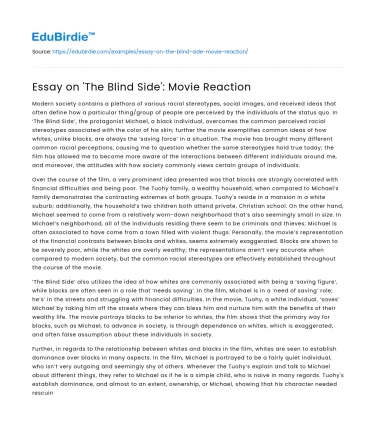Modern society contains a plethora of various racial stereotypes, social images, and received ideas that often define how a particular thing/group of people are perceived by the individuals of the status quo. In ‘The Blind Side’, the protagonist Michael, a black individual, overcomes the common perceived racial stereotypes associated with the color of his skin; further the movie exemplifies common ideas of how whites, unlike blacks, are always the ‘saving force’ in a situation. The movie has brought many different common racial perceptions, causing me to question whether the same stereotypes hold true today; the film has allowed me to become more aware of the interactions between different individuals around me, and moreover, the attitudes with how society commonly views certain groups of individuals.
Over the course of the film, a very prominent idea presented was that blacks are strongly correlated with financial difficulties and being poor. The Tuohy family, a wealthy household, when compared to Michael’s family demonstrates the contrasting extremes of both groups. Tuohy's reside in a mansion in a white suburb; additionally, the household’s two children both attend private, Christian school. On the other hand, Michael seemed to come from a relatively worn-down neighborhood that’s also seemingly small in size. In Michael’s neighborhood, all of the individuals residing there seem to be criminals and thieves; Michael is often associated to have come from a town filled with violent thugs. Personally, the movie’s representation of the financial contrasts between blacks and whites, seems extremely exaggerated. Blacks are shown to be severely poor, while the whites are overly wealthy; the representations aren’t very accurate when compared to modern society, but the common racial stereotypes are effectively established throughout the course of the movie.
Save your time!
We can take care of your essay
- Proper editing and formatting
- Free revision, title page, and bibliography
- Flexible prices and money-back guarantee
‘The Blind Side’ also utilizes the idea of how whites are commonly associated with being a ‘saving figure’, while blacks are often seen in a role that ‘needs saving’. In the film, Michael is in a ‘need of saving’ role; he’s’ in the streets and struggling with financial difficulties. In the movie, Tuohy, a white individual, ‘saves’ Michael by taking him off the streets where they can bless him and nurture him with the benefits of their wealthy life. The movie portrays blacks to be inferior to whites; the film shows that the primary way for blacks, such as Michael, to advance in society, is through dependence on whites, which is exaggerated, and often false assumption about these individuals in society.
Further, in regards to the relationship between whites and blacks in the film, whites are seen to establish dominance over blacks in many aspects. In the film, Michael is portrayed to be a fairly quiet individual, who isn’t very outgoing and seemingly shy of others. Whenever the Tuohy’s explain and talk to Michael about different things, they refer to Michael as if he is a simple child, who is naive in many regards. Tuohy's establish dominance, and almost to an extent, ownership, or Michael, showing that his character needed rescuing and leadership from whites to achieve success and respect by other members in society. Another very clear common racial perception that was present throughout the movie was the idea that blacks are correlated with the sport of football. Granted, the movie may have chosen to link these two factors for the development of plot; even so, the common stereotype is still presented. Today, blacks as well as other races, in fact, are seen playing a multitude of different sports, even if common stereotypes say otherwise.
The film has sparked my questioning of society’s perceptions of blacks and whites in today’s society. If common stereotypes are so exaggerated that they depict blacks as financially poor and whites as overly-wealthy, it raises the question, when did these common perceptions of individuals get so exaggerated, and what were the exact causes of these over-exaggerated depictions? It’s very interesting to see how severely stereotypes have been shaped and morphed throughout the world as a result of historical incidents and various events. As individuals developed throughout time, their perceptions of race have been morphed to sometimes be flawed; people believe that racial relationships in the past hold true today, which is usually not the case. Although there is still evidence of racism and racial prejudice throughout the country, the extent to which races are presented throughout the movie are not the dominant cases seen in today’s society.
The movie, ‘The Blind Side’, has affected my views on various ideas and perceptions in today’s world. As I saw how the stereotypes presented throughout the film were extremely exaggerated, it caused me to challenge and question how valid other stereotypes present in society. I am now more skeptical about stereotypes and commonly question whether any stereotypes, in fact, are valid. It’s very interesting when analyzing how these perceptions about people/things form in the first place. Although stereotypes enable us, as individuals, to quickly and efficiently respond rapidly to situations we may have had a similar experience before, at the same time, it makes us very ignorant as people. Stereotypes cause us to shy away from differences between individuals; they cause us to think very generally and we often fail to see uniqueness and originality within individuals, races, etc. The movie has allowed me to see that stereotypes are only in this world for us to save time. As humans, we want to progress with life as fast as possible, however if we take a little time, we can empirically see different meanings and hidden features within races, cultures and ethnic groups. It’s disappointing that stereotypes are almost a ‘natural’ part of individuals; however, when possible, taking one’s time can allow you to see the uniqueness and originality of various groups, races, and individuals.






 Stuck on your essay?
Stuck on your essay?

